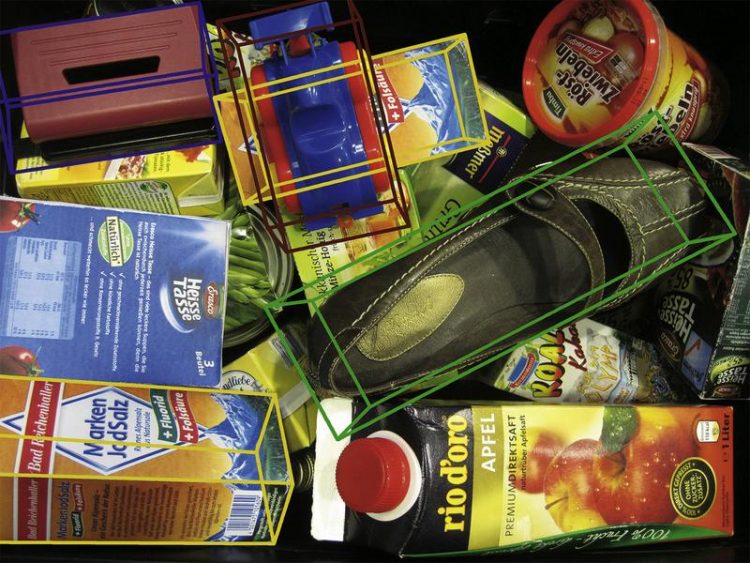Innovative image processing for service robots

3D object recognition in variable light conditions or when partially hidden. Image credit: Fraunhofer IPA
Warehouse robots capable of sorting chaotically delivered parts; domestic assistance robots able to distinguish between graspable objects and living areas; cleaning robots that detect and remove dirt: the systems developed at Fraunhofer IPA for three-dimensional object recognition and environment sensing allow robots to accomplish even complex tasks.
At Automatica 2014, Fraunhofer IPA will present innovative technologies for image processing and collision-free manipulation in a dynamic environment.
Accurate, fast, flexible and easy to operate for the user: these are the key criteria for real-world 3D image-processing solutions for robot systems. Fraunhofer IPA has developed a diverse and versatile software library for automatic object recognition and teach-in as well as for three-dimensional environment sensing.
At Automatica 2014, Fraunhofer IPA will demonstrate not only how a robot system can execute collision-free motions, including in a dynamic environment, but also how it can reliably recognize, classify and grasp objects.
Recognition and classification of textured and textureless objects
To reliably manipulate objects in a dynamic everyday environment, a robot system must be capable of recognizing and localizing the objects. The image processing searches selectively for feature points, which are assembled into a model and stored. This makes it possible for objects to be recognized also in variable light conditions or when partially hidden. And that’s not all the 3D object recognition system can do: the combination of geometrical shapes also allows it to determine the class or category of an object.
For example, the robot “knows” that a table is made up of a horizontal panel on top of four vertical cylinders, that a bottle is an oblong cylinder, a milk carton is a rectangular solid and a dish is a hemisphere. “Thanks to the combination of object recognition and classification, the robot can independently ‘learn’, or be intuitively taught to identify, specific objects or general object classes,” explains Jan Fischer, research assistant in the Robot and Assistance Systems department.
“Also in a variable environment, it is capable of reliably recognizing objects – in under a second.” The exhibit at Automatica 2014 will demonstrate the fast and reliable recognition of any object in an undefined environment.
Environment perception
To generate a 3D map, the robot senses its environment three-dimensionally using a combination of colour camera and depth camera, which produces a point cloud with accurately assigned distance values. The point clouds, which are recorded at different times, must first be registered in a common coordinate system. Next, the point data are segmented into geometric primitives, such as polygons.
This makes it possible for the relevant regions and objects to be reliably identified in real-time. In addition to collision-free navigation and manipulation, this also allows the option of remote control by a human operator, who can make sense of the communicated data more quickly. “We have many years of experience in this area and can offer a versatile technology capable of being tailored to suit different requirements and applications,” says Georg Arbeiter, project manager in the Robot and Assistance Systems department.
The exhibit at Automatica 2014 will demonstrate collision-free manipulation in a dynamic environment. Workpieces are moved alternately by two robot arms, the second arm in each case representing a dynamic obstacle. The methods developed by Fraunhofer IPA use camera data to generate an environment model that is used as an input for planning the motion of a robot arm. Both moving obstacles and graspable objects can be identified. This makes the method suitable for applications requiring fast and flexible reactions to changes in environment.
Applications
Learnable 3D object recognition and environment sensing can be used in a variety of areas and have been successfully implemented by Fraunhofer IPA in a wide range of different applications:
-in an industrial setting for autonomous driverless transport systems or for handling, warehousing and sorting operations;
-as a key technology for developing advanced assistance robots designed to provide a higher quality of life to people who are in need of assistance;
-to support growing automation in agriculture, e.g. to detect when fruit and vegetables are ready for picking or to enable milking robots to identify and localize cows’ udders;
-to enable cleaning robots to automatically detect dirt.
Contact
Dipl.-Ing. Georg Arbeiter, georg.arbeiter@ipa.fraunhofer.de, phone +49 711 970-1299
Richard Bormann M.Sc., richard.bormann@ipa.fraunhofer.de, phone +49 711 970-1062
Dipl.-Inf. Jan Fischer, jan.fischer@ipa.fraunhofer.de, phone +49 711 970-1191
More at Automatica – 6th International Trade Fair for Automation and Mechatronics
3 to 6 June 2014
New Trade Fair Centre Munich
Hall A4 | Stand 530
www.automatica-munich.com
http://www.ipa.fraunhofer.de/6D-Objekterkennung.520.0.html?&L=2http://www.ip…
Media Contact
All latest news from the category: Trade Fair News
Newest articles

Parallel Paths: Understanding Malaria Resistance in Chimpanzees and Humans
The closest relatives of humans adapt genetically to habitats and infections Survival of the Fittest: Genetic Adaptations Uncovered in Chimpanzees Görlitz, 10.01.2025. Chimpanzees have genetic adaptations that help them survive…

You are What You Eat—Stanford Study Links Fiber to Anti-Cancer Gene Modulation
The Fiber Gap: A Growing Concern in American Diets Fiber is well known to be an important part of a healthy diet, yet less than 10% of Americans eat the minimum recommended…

Trust Your Gut—RNA-Protein Discovery for Better Immunity
HIRI researchers uncover control mechanisms of polysaccharide utilization in Bacteroides thetaiotaomicron. Researchers at the Helmholtz Institute for RNA-based Infection Research (HIRI) and the Julius-Maximilians-Universität (JMU) in Würzburg have identified a…



